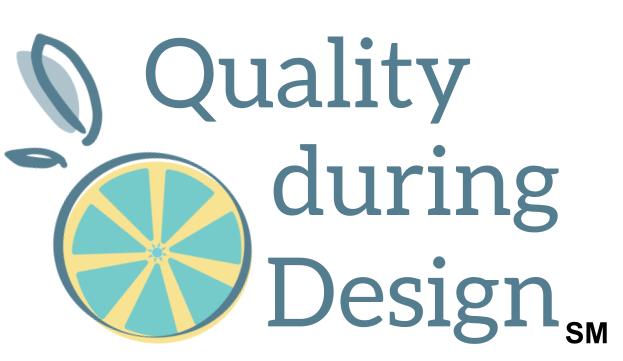Welcome to Quality during Design for products, others love for less. I'm your host, Dianna Deeney. We're wrapping up a "Versus Series" where we've been comparing different quality and reliability methods and techniques and tools and learning how they get applied to product development and design engineering. In all of these episodes, we've been talking about some principles of quality and reliability engineering, namely that we can use them to essentially prune the product development process. Because these tools are people-focused, risk-based and they can help us uncover ideas, navigate decisions and empower teams, they are very useful in our toolbox for early concept development work.
There is a power tool that we haven't really gotten into yet, and I was reserving it for this last episode, and that is failure mode and effects analysis. And the topic in comparison that we're going to be doing today is comparing use FMEA versus design FMEA, or you've probably also seen them as UFMEA and DFMEA. And in this case, the design FMEA we'll be talking about is the system level or top-level product FMEA.
Now these two FMEAs are really excellent at getting team buy-in, developing concepts and ideas, and fostering that risk-based thinking early in the concept development. And we can use them iteratively through product development and in the field. What are these two different FMEAs? How do they differ from each other and how are they alike? And do we need to do both of them? What kind of information do we get out of each that can benefit the product development process?
Well, first of all, FMEA, failure mode and effects analysis (or sometimes failure modes and effects analysis) is really a tool. It's a tool that we can use with our team and our cross-functional team to systematically understand risks and to be able to make based decisions throughout the product development process. The scope of FMEA is really focused on errors and failures, but we can look at them as symptoms that the product or the system that we're designing could be better. FMEA is an analysis, the goals of which we want to identify and assess potential problems and their effects, minimize or eliminate those through changes, or stabilize them.
When we use FMEA during development, during concept development, it helps a team prioritize efforts and focus. The big benefit is that it gets a cross-functional team to communicate and maybe commiserate with each other. After development, it helps a team understand the risks of the design and decide if it's acceptable or not. If it's not acceptable, then some different action needs to be taken.
Many groups use a hierarchy of FMEAs, different levels of product design, use cases and manufacturing methods, each FMEA focused on a particular aspect of a product and its development. But we don't need to do FMEA on everything. We can use the top level, high level FMEAs to identify the areas that are most prone to failures or problems, and maybe focus in on another sub-level FMEA for that.
The two FMEAs that we're comparing today are, I consider, top level FMEAs, and that's use FMEA and DFMEA.
What is a UFMEA? Well, the focus is on human factors. The scope is human error and use error. Those are the kind of things we're looking for in evaluating with a UFMEA. The goals with this analysis to integrate the human needs, capabilities, and limitations, and to address the effects of human error with our product.
On the other hand, what is design FMEA? Its focus is different than a UFMEA. If focus is on design failures or the product system failures. It has different names depending on what the focus of it is. You may hear of this top level analysis as a system level, FMEA, or a product FMEA, maybe even a hazard analysis. The scope of a design FMEA is on the product system, failures and faults. And the goals are a little different than UFMEA, too. It's to integrate the technological needs and capabilities and limitations. We're analyzing how to address the effects of a product system failure.
Those are some of the differences between a UFMEA and a DFMEA of the system product level DFMEA. There are some similarities. The analysis coming from a UFMEA and a system level DFMEA are both inputs into concept design into the requirements and even test planning, both the human factors testing and product testing. Both documents are also considered living documents, meaning they're maintained throughout development and sustaining activities. Sustaining activities are those activities like field monitoring, complaint analysis, and so on. We can even add a criticality aspect to it where they become FMECA, which is another way for us to rank and prioritize our efforts actions and help us make decisions.
Besides the similarities in them just being FMEAs, they do relate to one another. Another way that UFMEA and DFMEA relate is through the interface between the product and the user. When we're thinking just about the product, we're thinking that there is an input, the product has a process where it's doing something or accomplishing something, and then there is an output. On the other side of this, almost mirrored, is the process of the user. The user gets input - they're perceiving something from our product. They do something with our product and interact with it, and then they decide what kind of control or action that they want to take with our product.
When we marry these together, we can think of them as a continuous loop and a cycle where wherever our user is deciding to do something with a control, that's our input into our product design. And whatever our output is of our product design is an input into our users' perception. A UFMEA evaluates the user's perception process and control decisions. And a design FMEA evaluates our product or our system, its input, the process and its output. These two different analyses are focused on different things, but they both affect the product design and the choices that we make about how our product is going to function and the features that it has. It's worth while evaluating our product design from both of these angles.
I understand and have seen the value of FMEAs, especially with a cross-functional team: garnering ideas, helping them make decisions, and working toward a common goal. It's made the design of whatever that we were analyzing better in the end: safer, easier to use more dependable. And I'm not sure that the team would've came to the same kind of decisions unless we had gotten together and talked about it. FMEA provides a framework for cross-functional teams to be able to do this.
Even so, there are some strong feelings about FMEA. Some people love them and some people despise them. I don't know that I would go so far as to say I love them, but let's talk about some of the objections that people have with FMEA.
One of the actions is that FMEAs aren't value added to the project. And I agree that if we wait until the end of the project, when everything's already designed and settled, and we're not really allowed or can make any changes for improvements, then it is too late. It really isn't value added. That's why we want to do FMEAs early and then iterate on them through the concept development process. This allows us to talk about and make decisions during the design process, not just assess what we've already done. But FMEAs aren't just for development. It's also for sustaining activities. Like when we need to figure out root causes of field failures, as one example.
Another objection is that FMEAs are just too difficult, but I don't think they're difficult to start if we start with a concept, a high-level idea. We can still evaluate those with an FMEA and use risk based thinking. We're going to uncover ideas that shape the design itself and help us define the requirements. Something else that helps with an FMEA process that might seem too difficult is having a plan. FMEA starts out as a team thought experiment. So, create a plan or a test protocol. If, you will. Take some time to get everyone on the same page, with the scope of what we're talking about, the rating scales, how we rate things and the acceptance criteria that's going to trigger action.
A third objective I've heard is that we can't even get started with an FMEA until we have the design all figured out. Instead think of it as a way to empower design engineers, to get the broader team's input and experiences. We are allowed to start with empirical methods, ideas, presumptions, and potential ideas. And as we learn more and iterate on our design, then we can move to analytical method where we're further assessing things with the data that we get from tests, from experiments, with the real thing.
The last objection that I'll talk about in this episode is we don't have time. It costs too much to do it. It does take time. There is a life cycle costing book that suggested that each function or piece of equipment of a DFMEA takes a bit less than 18 total people hours. A team of five working on an FMEA for equipment - it could take three hours, but that would be over the lifetime of product development. Done right, FMEA is a preventive activity. Designing-in controls is often more effective and cheaper and easier than trying to manage failures at the back end. FMEA helps the team throughout the product development process. And it helps other internal customers with maintaining the product in the market. So FMEA does take time, but the team also saves time in the long run, especially when treated as a living document.
FMEAs are not the only way to assess risk and make risk based decisions. There is event tree analysis and fault tree analysis, and those help us get more detail on multiple causes for a failure event. SWIFT is a Structured What If Technique. We can evaluate the user process with a process flow and task analysis. But here's a tip: many of these different analyses could be an input into an FMEA where we're further evaluating the high-risk items.
So what's, today's insight to action? Do risk analyses early and iteratively. Talk about the user and the product itself because we're designing products to do something for a user. Do both UFMEA and a system level design FMEA, because they focus on different things.


